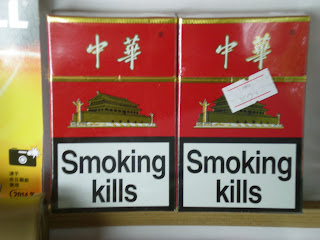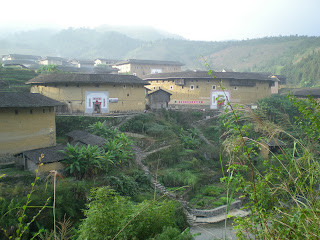 so, after returning from the tu lou village, we visited a tropical island. well, not really, but it was really hot and humid and certainly looked like one. the island is called Gulongyu and is literally a 5 minute ferry ride from the mainland. it was inhabited by europeans after the opium wars and therefore has a gorgeous collection of old european homes, of which i do not have any pictures owing to the fact i did not have my camera when i came across said homes. mostly, the homes are now extremely run down and are occupied by local chinese residents. however, it is possible to see what they used to be. the flowers on the island were gorgeous, just like everywhere else in China. the island is relatively small, but getting lost takes little effort. the beaches are ok, but the water is polluted os it was recommended that we don't swim. i preferred to spend the rest of the trip relatively healthy, so i followed this particular suggestion. the island also had many many bugs, huge giant misquotoes and, as it turned out, mites in the hotel bed sheets, but lucky for me, not all the bed sheets.
so, after returning from the tu lou village, we visited a tropical island. well, not really, but it was really hot and humid and certainly looked like one. the island is called Gulongyu and is literally a 5 minute ferry ride from the mainland. it was inhabited by europeans after the opium wars and therefore has a gorgeous collection of old european homes, of which i do not have any pictures owing to the fact i did not have my camera when i came across said homes. mostly, the homes are now extremely run down and are occupied by local chinese residents. however, it is possible to see what they used to be. the flowers on the island were gorgeous, just like everywhere else in China. the island is relatively small, but getting lost takes little effort. the beaches are ok, but the water is polluted os it was recommended that we don't swim. i preferred to spend the rest of the trip relatively healthy, so i followed this particular suggestion. the island also had many many bugs, huge giant misquotoes and, as it turned out, mites in the hotel bed sheets, but lucky for me, not all the bed sheets.
i thought this was a little creepy, but it was really cool to walk by in the morning when the island's residents were doing taichi.






after the island, we were lucky enough to visit Ximen's famous botanical garden. we spent 2 hours literally hiking through the gardens enjoying all the flowers and local people.





 after the gardens, we hopped back on the train, this time only for 12 hours overnight. we went north to see tea production. we stayed in a small village where producing tea is the main income. the village was small and localted in a valley surrounded by beautiful mountain scenery, which we were lucky enough to hike through. for 4 hours. after it had rained. needless to say, none of us returned clean and the next day most of us were pretty sore.
after the gardens, we hopped back on the train, this time only for 12 hours overnight. we went north to see tea production. we stayed in a small village where producing tea is the main income. the village was small and localted in a valley surrounded by beautiful mountain scenery, which we were lucky enough to hike through. for 4 hours. after it had rained. needless to say, none of us returned clean and the next day most of us were pretty sore.there is not much to do in the village after dinner, so some of the SYA students, myself included, learned to play mahjong from the local residents. mahjong is a bit like the card game rummy, only with tiles. the locals got really into the game and whenever we made a mistake, they would get really agitated and start playing for us.


 the next day, we learned all about the different steps for tea production. there are many different kinds of tea produced in China, but we learned about the production of what would be called oolong tea in Fujian providence.
the next day, we learned all about the different steps for tea production. there are many different kinds of tea produced in China, but we learned about the production of what would be called oolong tea in Fujian providence.
to further dry the tea, the tea is put in a tumbler and turned, manually, for about 16 hours. we only turned it for about 20 minutes. then, as pictured above, the tea is put into another tumber, only this one is powered by heat. this further dries out the tea leaves.

i never really understood what this machine did to the tea, but i think it just rolls and flattens it.

lastly, the remaining stems are plucked off the tea leaves which are packaged and sold wholesale to manufacturers, who then sell the tea in the cities. the manufactures purchase the tea for 1/10 of the price they sell it for in the cities, so you can see who really makes the prfit here. the tea we made was worthless as we skimped out on all the steps, but it was fun to see the whole process.

 another 12 hour night on the train north later, and we arrived in Suzhou. despite getting up at 5:15 in the morning to get off at the correct stop, we had a full day ahead of us. first, we went to an embroidery workshop. most of the pieces take up to a full year to create. the workers are paid about 8,000 RMB a year, or a little over 1,000 dollars, and their work is sold for about 35,000 RMB. talk about exploiting the workers. anyway, the pieces created were absolutley beautiful and full of color.
another 12 hour night on the train north later, and we arrived in Suzhou. despite getting up at 5:15 in the morning to get off at the correct stop, we had a full day ahead of us. first, we went to an embroidery workshop. most of the pieces take up to a full year to create. the workers are paid about 8,000 RMB a year, or a little over 1,000 dollars, and their work is sold for about 35,000 RMB. talk about exploiting the workers. anyway, the pieces created were absolutley beautiful and full of color.
after the embroidery workshop, we visited one of the most famous gardens in China. which had, of course, more beautiful flowers and stunning architecture.





in the afternoon, we visited a silk factory. above, the silk thread is being taken from the cacoons of the silk worms. the silk facotry was amazing, but the main purpose of the factory was selling silk at the end. the silk was not overpriced, but i didn't have enough room in my bags to buy much. besides, it is possible to purchase the same silk in beijing for a reasonable price.

the next day, tuesday, we hopped on a bus for a 1 1/2 hour bus ride to zhouzhuang, a well preserved canal town. the architecture was amazing, but zhouzhuang turned out to be really touristy. tons of tour groups wandered around, trying to discreetly take our pictures, sometime just asking. the food was not that great. however, looking around was fun. i took a boat ride on the canals and saw different parts of the small city.



on the final day of our trip, we visited an orphange in Suzhou. i made dumplings with the little kids. most of the kids have physical or mental disabilities and will probably never be adopted. the orphanage was part of a welfar home which also provided care for the elderly. we had a fun afternoon looking around the orphanage and giving candy to small children, much to the dismay of the people who worked there.

we were also lucky enough to visit a special enonomic zone in Suzhou. the governmen provides perks to businesses who set up there, and it is a haven for overseas businesses. we got a tour of a Japanese company which makes the aircompressors used for air conditioners.

we also visited a school for kindergarten teachers. the school has 1597 female students and 3 male students. the education stretches over 5 years and most of the graduates are 21 when the graduate. we had fun talking with the students and playing basketball in their gym class.
so after a whirlwind 2 week vacation, i am happy to be back in Beijing where i was greeted with 100 new e-mails and all the news from the past 2 weeks. i already knew about the US's new president elect because most of the SYA students called home the day of the election. we were in the middle of a gym class with the students in the town near the tu lou village and were happy for an excuse to stop embarrassing ourselves. basically, a bunch a 7th graders were walking all over us. we needed an excuse to stop their teacher from laughing too hard.
so that is my vacation in a nutshell. thanks for reading,
Stephanie

























